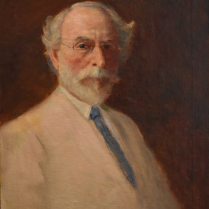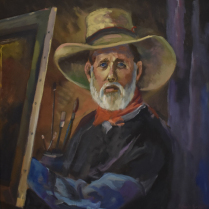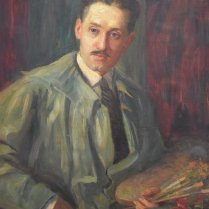calsfoundation@cals.org
Three Generations of Artistry: Brewer Family Exhibition Brings Famed WWII Painting, Luminous Landscapes
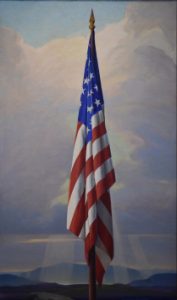
“A Legacy of Brewers” is now open in the West Gallery, featuring works by three generations of Brewer painters. Some of the paintings have not been on public display for twenty years. Others have never been available to the public at all. The most famous painting, Adrian Brewer’s “Sentinel of Freedom,” is on loan from the Naval Academy in Annapolis, Maryland. This celebrated depiction of the American flag soared to popularity after its creation in 1941 and was used countless times as a patriotic emblem during and after WWII.
The Brewers contributed their significant talent to nurture the art scene in Arkansas in the 1930s. Nicholas (known as ‘N.R.’) and his son Adrian painted striking landscapes depicting southwestern states as well as Arkansas scenes. Edwin, the youngest, showed stylistic variety in his work as well as a more contemporary edge.
The three Brewers’ lush paintings, usually kept out of public view in private collections, will be exhibited together thanks to collaboration among Adrian’s grandsons, Larry and Lou Graham, and a number of other collectors who have loaned paintings to the Butler Center Galleries.
Viewers will be able to see common elements in the Brewers’ work as well as how trends in the art world may have influenced their stylistic differences and choice of subjects.
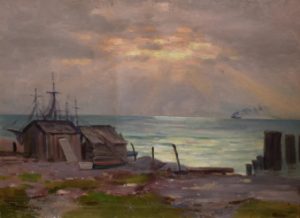
Nicholas ‘N.R.’ Brewer, the first generation painter, was known for romantic, moody landscapes as well as his portraits. Described by those who knew him as “grandiose,” and “larger than life,” N.R. had six sons. Three of them showed artistic talent, but Adrian was the one who inherited his father’s mantle and brought the family legacy to new heights. There was reportedly some rivalry between father and son after Adrian won a Texas art competition they had both entered, but they patched up their differences eventually.
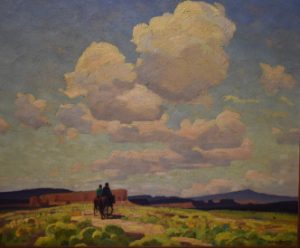
Adrian’s work often shows brighter colors and sharper relief. His expert use of ‘raking light’ makes many of his landscapes appear to glow from within. Adrian completed many southwestern landscapes. When Adrian was offered a commission to paint Franklin Delano Roosevelt, he instead gave the commission to his father N.R., who had always wanted to paint a president.
Adrian founded a teaching art studio in 1932 in downtown Little Rock, where he spent time with famed Arkansas poet John Gould Fletcher as guests played violin, recited poetry, or listened to Josef Rosenberg play the piano. The Brewers also assisted in the establishment of the Little Rock art community.
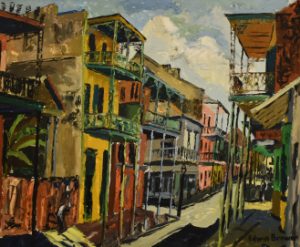
Youngest of the line was Edwin Brewer, who moved one step farther from the realistic landscapes of his father and grandfather. In addition to impressionistic scenes like the one shown here, Edwin’s work in the show includes black and white lithographs of Vietnam as well as one completely abstract painting.
There are some fascinating details in the life of the Brewer family that can only be imagined, even with the insightful commentary offered by Adrian Brewer’s grandsons Larry Graham and Lou Graham. Those details add to the human story for the thoughtful visitor to the exhibition.
Only one of N.R.’s sons became a celebrated artist, even though two of the other five sons tried their hands at art or craft.
Edwin had a twin brother named Adrian Jr., who finished only one painting before abandoning art in favor of hunting and outdoor pursuits.
One is left to wonder whether the sons of this family chose their careers from nature or from nurture. The talent may have been present in the genes, but it only blossomed in a few of the Brewers.
Were the fathers tender with their sons’ youthful work, as the boys grew up surrounded by paintings in art studios? Did adult hands guide young hands on brushes, and did fathers praise promising efforts? Or did N.R. and Adrian, both known for their passionate artistic temperaments, ever critique their sons harshly?
We may never get that glimpse of fathers and sons behind closed studio doors, but the paintings give us at least some idea of the rich artistic environment that nurtured these considerable talents.
The Brewer paintings are popular with collectors and have sparked an active collector community. “A Legacy of Brewers” opened at the Butler Center Gallery West on July 13 and will remain on view through October 27.
The Butler Center is grateful to Larry Graham and Lou Graham, grandsons of Adrian Brewer, for their insightful commentary on the lives of the Brewers in an interview conducted at the Butler Center on July 12, 2018. Their comments are one source for this article.
Also consulted: Adrian Brewer: Arkansas Artist. Text by Jolynda Halinski with the assistance of Betty Brewer Rice and the family of Adrian Brewer. Department of Art, University of Arkansas at Little Rock, 1996.
